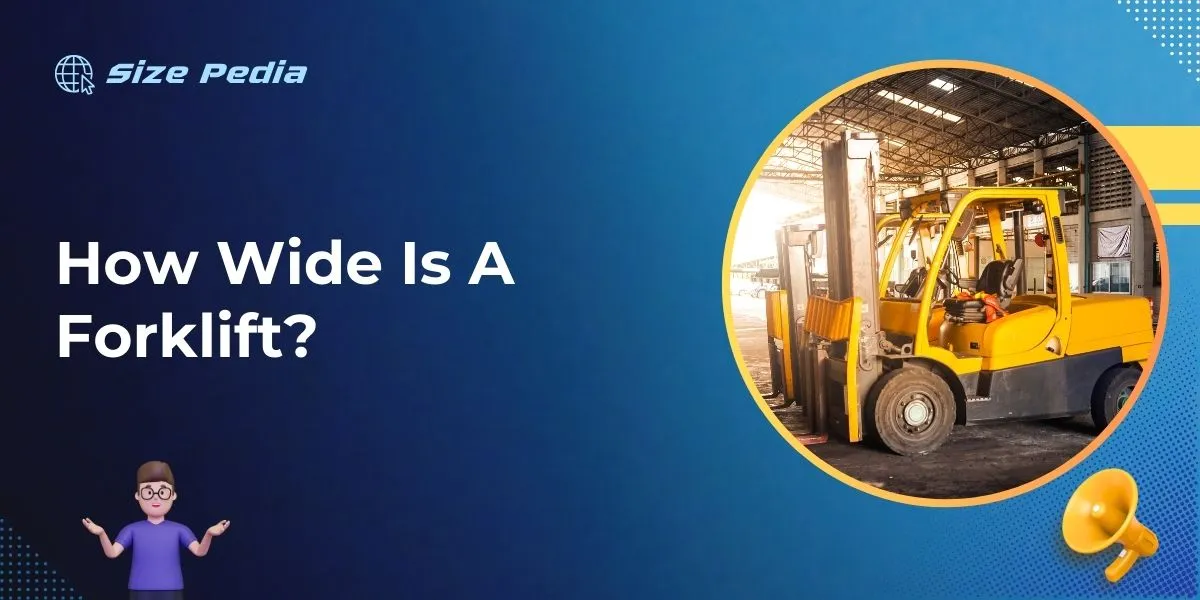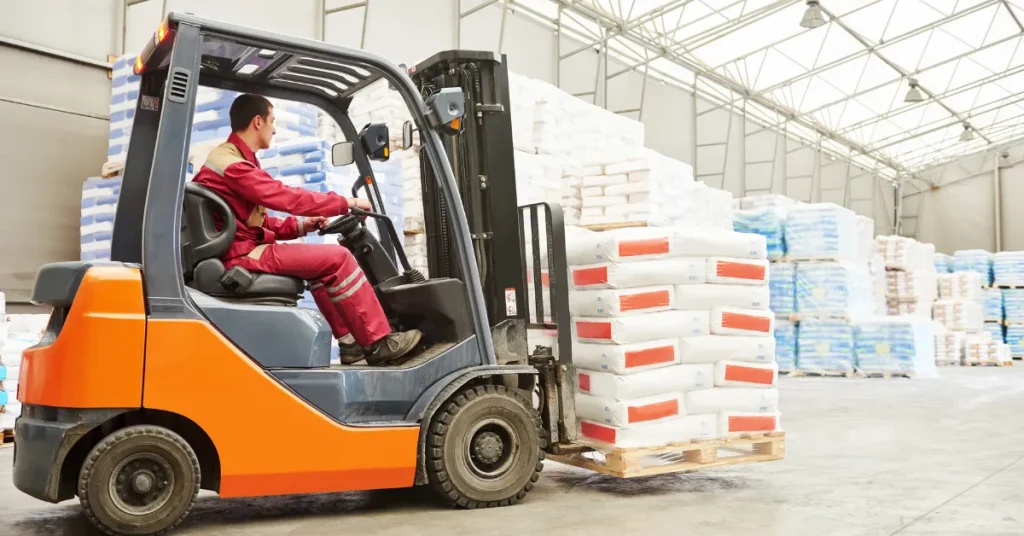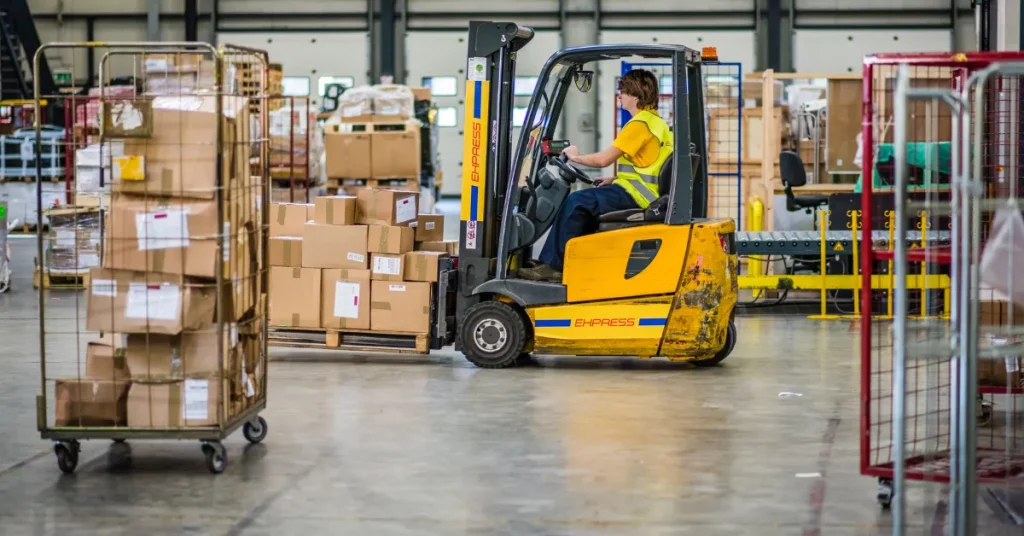A typical forklift is approximately 4 to 7 feet wide. Sizes may vary based on the model and capacity.
Understanding the width of a forklift is crucial for navigating through the aisles of warehouses and loading docks efficiently.
These powerful industrial vehicles are designed to operate in tight spaces, yet their size can be a deciding factor in optimizing workspace layout.
Standard forklifts are crafted to move loads of varying sizes, hence the width can significantly influence the turning radius and aisle clearance needed.
Safety and operational efficiency depend on knowing the vehicle’s dimensions. Warehouse managers and logistics professionals must consider these measurements when planning storage solutions and workflow processes.
Selecting the right forklift width ensures seamless integration with your facility’s space constraints and operating requirements.

Anatomy Of A Forklift
Understanding the anatomy of a forklift is crucial. This knowledge helps ensure safe and efficient handling of these powerful machines. Let’s explore the key components and standard measurements that make up a forklift’s structure.
Key Components
Forklifts consist of several essential parts. Each part plays a vital role in the forklift’s function. Here is a brief overview:
- Mast: The tall vertical part that lifts and lowers the load.
- Forks: The horizontal arms that carry the load.
- Counterweight: A weight located at the rear, providing balance.
- Power Source: Batteries or fuel engine that powers the forklift.
- Overhead Guard: A cage-like structure protecting the operator from falling objects.
Standard Measurements
The width of a forklift is an important measurement. It affects the machine’s maneuverability and safe operation. Here are the common dimensions:
| Forklift Type | Width Range |
| Warehouse Forklift | 3.5 to 4.6 feet |
| Side Loader | 4.5 to 5.8 feet |
| Counterbalance Forklift | 3.9 to 4.9 feet |
Remember, these dimensions can vary. Always check the forklift’s manual for exact measurements.
Factors Influencing Forklift Width

Think of a forklift and its width might not immediately spring to mind. Yet, forklift width is critical to maneuvering in tight spaces. Various factors determine how wide a forklift can be. A clear understanding of these can inform the best choice for specific tasks.
Model Variations
Forklifts come in many shapes and sizes. Model variations impact the width. Different manufacturers produce models for various environments.
For instance, narrow aisle forklifts are slimmer than industrial ones. The model chosen directly affects the width. Let’s explore further:
- Standard forklifts typically measure around 4 feet wide.
- Narrow aisle trucks, designed for tight spaces, can be much slimmer.
- Large capacity forklifts can exceed 7 feet in width to accommodate heavier loads.
Load Capacity
Forklift width often correlates with load capacity. Higher capacity equals wider designs. This ensures stability and safety when handling heavy loads. Consider these details:
| Load Capacity | Approximate Width |
| 3,000 lbs | 4 feet |
| 5,000 lbs | 4.5 feet |
| 10,000+ lbs | 5 feet and up |
The table above shows typical widths. Each increase in weight capacity can add to the forklift’s width. Always check your needs against the forklift’s specifications. Ensure it fits in the operating space.
Industry Standards
Forklifts are essential workhorses in warehouses and job sites around the world. Their sizes can vary. But, industry norms guide their dimensions.
These norms ensure forklifts fit through standard doorways and operate in common workspaces. Here, we’ll explore the usual widths of forklifts and how these may differ internationally.
Typical Dimensions
The width of a forklift is crucial. It affects maneuverability and safety. Most forklifts are between 4 to 7 feet wide. This size allows easy operation in tight spaces.
- Standard models: Typically 4 to 5 feet wide.
- Larger capacity models: Reach up to 7 feet in width.
These dimensions make sure that forklifts can navigate aisles and loading docks efficiently.
International Specification Differences
While there are similarities, forklift dimensions can vary globally. Different countries may have unique warehouse designs and door widths. That’s why forklift sizes may not be the same everywhere.
| Region | Forklift Width Standards |
| USA | 4 to 7 feet |
| Europe | 1.2 to 2.0 meters |
| Asia | Varies widely |
It’s important for businesses to consider these differences. They should choose the right forklift size for their operations. Proper size ensures safety and improves workflow.
Navigating Tight Spaces
Navigating tight spaces in warehouses is a common challenge. The width of a forklift plays a crucial role in how effectively it can maneuver through these spaces.
Understanding the dimensions of your forklift and the design of your warehouse ensures smooth operation and optimizes your storage capacity.
Warehouse Design
Effective warehouse design maximizes space usage while allowing forklifts to operate efficiently. Key factors include:
- Aisle width relative to forklift size
- Shelving height and configuration
- Turn radius requirements for different forklift models
Optimize layout to enhance forklift mobility. This includes sufficient clearance for loading and unloading.
Aisle dimensions should always exceed forklift width to prevent accidents and damage to goods.
Narrow Aisle Equipment
Forklifts designed for narrow aisles exist. They are ideal for tight spaces. Consider these equipment types:
| Equipment Type | Width |
| Reach Truck | 8 feet or less |
| Turret Truck | 7 feet or less |
| Order Picker | 6 feet or less |
Narrow aisle forklifts require less space to operate. They are perfect for maximizing storage. Training operators and regular maintenance are crucial for safety and efficiency.
Choosing The Right Size Forklift For Your Needs

When selecting a forklift, size matters. The width of a forklift impacts its maneuverability and the space it requires. It influences where and how a forklift can operate.
It’s crucial to choose a forklift that fits your workspace and job demands. Let’s explore how to pick the right size.
Assessment Criteria
Determining the perfect size begins with assessment. Check these factors:
- Aisle Width: Measure the narrowest space the forklift will navigate.
- Load Width: Note the typical width of loads you’ll carry.
- Doorway and Rack Dimensions: Confirm entry points and storage fit the forklift width.
Consolidate these metrics into a clear profile. This will guide your choice.
Customization Options
Forklifts come with different customization options.
| Feature | Customization Benefit |
| Mast Height | Adapts to various clearance levels |
| Fork Length | Matches different load sizes |
| Tire Type | Enhances movement in specific environments |
Consider add-ons like side shifters or fork positioners. They allow for adjustments according to the task at hand.
FAQs About How Wide Is A Forklift
What Is The Width Of A Forklift?
The width of a forklift varies based on the model, ranging from 3 to 7 feet (36 to 84 inches) typically.
What Is The Average Width Of A Forklift Fork?
The average width of forklift forks is approximately 4 to 6 inches (10 to 15 centimeters).
How Much Space Do You Need For A Forklift?
A forklift typically requires an aisle width of about 12 feet to operate safely and efficiently. Ensure you have enough clearance for maneuvering and turning.
How Wide Is A Toyota Forklift?
The width of a Toyota forklift varies by model, typically ranging from 3. 2 feet (0. 97 meters) to 4. 5 feet (1. 37 meters).
Conclusion
Understanding the width of a forklift is crucial for efficient warehouse management and safe operation. This post has guided you through the various sizes and factors that affect a forklift’s width.
With this knowledge, you can optimize your workspace and choose the right equipment, ensuring both productivity and safety.
Remember, selecting the appropriate forklift size impacts maneuverability and operational success.
Resources:
1. https://www.osha.gov/etools/powered-industrial-trucks/operating-forklift/load-handling
